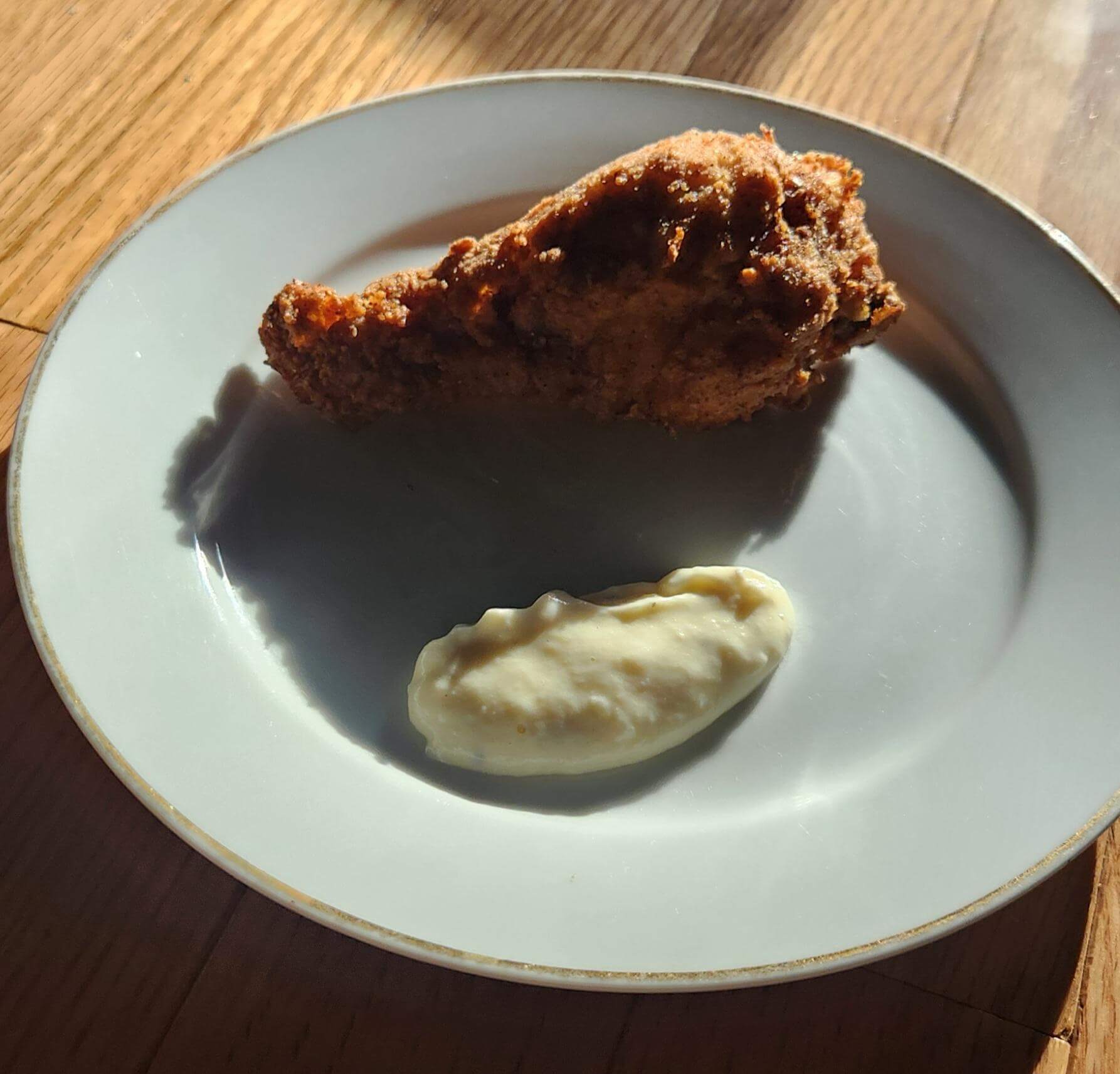AV on the Menu: Does Fried Chicken Taste Better with "Sonic Seasoning?"

“Jingle your tastebuds,” reads an ad for Parmesan truffle chicken at a KFC in Singapore.
How do you do that, exactly? For starters, you can scan the QR code and learn about their recent marketing play called “sonic seasoning.”
But is it a gimmick or is it actually scientifically-backed? Can something be both? Let’s dig in.
What is Sonic Seasoning?
Sonic seasoning, as it’s defined by the journal Frontiers in Psychology, is the deliberate pairing of sound or music with a specific taste or flavor in order to enhance or modify the sensory experience. In non-journal terms, you listen to something while you eat and it makes you feel a certain way. Over the past few years, the concept has sprung up in the culinary world as a way to add a new level of immersion to food experiences.
It’s not a wild concept to imagine that a particular song may pair well with a certain meal. Would you listen to Cyndi Lauper while eating foie gras on vintage china? How about Beethoven while the grease of a Juicy Lucy drips down your chin? Does it really matter what your ears are experiencing as long as your taste buds are ready for the next bite?
"Taste and Pitch" Study by Kristian Holt-Hansen
To answer that question, it’s worth dissecting a 1968 study done at the University of Copenhagen by Kristian Holt-Hansen. Participants in this study were asked to drink two beer samples (Carlsberg Lager and Carlsberg Elephant Lager) while listening to varying pitches. They were then asked to identify the pitch that harmonized with the taste, and recorded this as the "note of harmony." "Harmonized" in this case meant feeling a perfect blend between the ears and taste buds, to the point where a warm, happy feeling was achieved. They also measured something they called the "limen of difference," or the degree to which the pitch could change and they still felt those warm fuzzy feelings. The results concluded that most participants felt their "note of harmony" around 510–520 Hz while drinking the Lager, and around 640–670 Hz for the Elephant Lager.
So, Back to KFC…
Yes, this is the second time I've covered KFC and AV (see Kala, the AI Intern) but this marketing technique is worth checking out. Last December, KFC Singapore was looking for a way to make their Parmesan Truffle Chicken a little more exciting around the holiday season. Working with R/GA Singapore, Professor Gemma Calvert from Nanyang Business School, and Massive Music to create a soundtrack perfect for eating the indulgent fast food.
It might sound totally arbitrary, but the neuroscientist working on this campaign (Calvert) claims there are actually perfect pitches to pair with flavor elements like crunchiness, creaminess, and tenderness. Going back to Holt-Hansen’s study, they claimed that feelings of comfort and ease developed when the perfect sounds and tastes combined. According to Calvert, higher frequencies will influence crispiness and lower frequencies give that truffle the depth of umami so many of us love. Obviously, crispiness is a texture not a flavor, so two very different sensations are being measured here.
This marketing tactic might not be as scientifically tested as color studies, but it’s not totally pseudoscience either. The catch, however, is getting people to actually participate. KFC released a video (you can watch below) that gave the results from their own mini experiment. The marketing genius here is that they included responses that both supported and refuted the sonic seasoning theory. And we all know from many viral moments over the years that a good debate is great for brands.
Putting it to the Test
The Chicken
Never one to turn down fried chicken, I decided to test it out myself. Currently, there is no way to get KFC’s Parmesan Truffle chicken as it was a limited-time offer in Singapore and has never been released in the US. However, I do have a KFC just a 10-ish minute drive from my house (It is America, afterall), and I’ve asked ChatGPT to help me create a Parmesan truffle sauce to dip their original recipe in. Here's what my material looked like:

First, I tried the chicken and sauce without any music. The first thing I noticed was that the sauce was delicious (who knew I was such a saucier? 💃) and KFC is really, really salty. I haven't eaten it in maybe 10-15 years, but I don't remember it being quite like this. Anyway, that sauce though! (comment for the recipe)
Next, I tried it with KFC’s rendition of "Jingle Bells" from their Spotify playlist made specifically for this promo. The song is a synthy, jazzed-up version of the classic holiday tune with a mix of low tones (supposedly for the truffle) and high frequencies (for the crispiness).
And last, I tried it with a song that I felt to be the antithesis of the “Jingle Your Taste Buds” song, which, in honor of the late Prince of Darkness, was “Iron Man” by Black Sabbath.
Did the chicken taste any different based on the music I played and the frequencies of the notes?
Call me crazy (and my husband did!), but while listening to "Jingle Bells" I seem to have been able to taste the truffle just a bit stronger. While listening to Black Sabbath, the chicken tasted saltier. This could have been because by the time I put on Ozzy my salt intake was through the roof. This. Chicken. Is. Salty.
Remember, this wasn't a blind study, it was really just an excuse to eat chicken. And I think I've eaten enough to last me another 10-15 years.
The Beer
I also gave the test a shot with the same Danish beer from the original sonic seasoning study. I’ve never had Carlsberg so I can’t say if this beer normally gives me feelings of “warmth, happiness, and relaxation” but here's what happened. I listened to a YouTube video of a 20-20,000 hz audio sweep while slowly sipping each beer. I stopped the video when I felt... any nice feeling.
First up was the lager, and I stopped the sweep at 209 hz. According to the study, the most common hz to feel the warmth with this beer was around 510–520 Hz. Maybe it was all that fried chicken talking, but I was able to get those cozy feelings a bit earlier than most.
Second, I tried the elephant lager. I will admit I don't know how this differs from the original, but it felt more difficult to drink—not as smooth, not as sweet. I didn't really get any warm fuzzy feelings while drinking it, and as the frequency climbed higher, I actually felt less comfortable. I am a person who is generally bothered by most noises, so this could be why the higher pitch slowly caused me to squirm. In general, with both beers, I felt much more comfortable during the lower frequencies.
The Takeaway
So, what did I learn from all of this other than fried chicken and beer on a Tuesday night will end your evening pretty early? 😴 Mostly that studies related to taste and auditory sensations are extremely subjective. This is not a shock to most, but asking a group of people to talk about feelings is not very scientific and frankly doesn't give you much concrete evidence at all.
There are also a ton of variables you just can't control here, for example, who actually liked the taste of this beer? And in the case of the KFC participants, were they reporting on whether the music made the food taste "better" or specifically more "truffly" or crispier? The fact that the 1968 study was conducted with beer also begs the obvious question: were the participants just getting drunker?
There have been studies done on the relation of music and food intake and it's likely that treating our senses simultaneously leads to general feelings of comfort. Whether that's wearing soft slippers while eating chicken soup or smelling your grandma's cookies while listening to Michael Bublé, watching the snow fall outside. Sometimes all the senses wrapped up in a nice little bow are just... nice.
I think there's a lot to be said about the crossover of senses, and the experiences of synesthetes are fascinating. Though creating a jingle for a marketing campaign to sell chicken is just that—a marketing campaign. And while I think I've done my part steering you all away from KFC, if you do want to try some A+ fried chicken, I recently visited Succotash in DC and that chicken was **chef's kiss.** Though fair warning, the ambiance is a little loud.
Image credit: Getty/SasinParaksa
-
AV on the Menu

AV on the Menu is a series of articles that dive into the intersection of the culinary world and the AV industry. Whether it’s immersive dishes, projection-mapped tables, or digital menus, this series will not only have you drooling but learning about exciting new tech, too.






Please sign in or register for FREE
If you are a registered user on AVIXA Xchange, please sign in
Going to start making Filipino sauces with ChatGPT's help, loved the personal experiment here! (RIP Ozzy btw)
Yes! More homemade sauces in general. So easy to make.